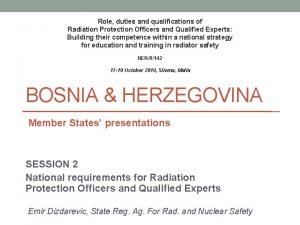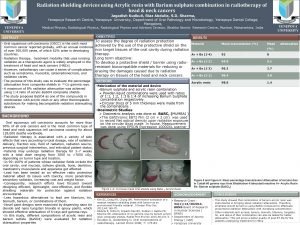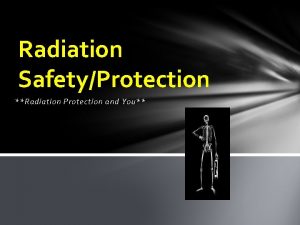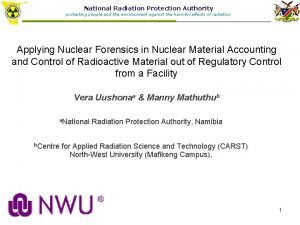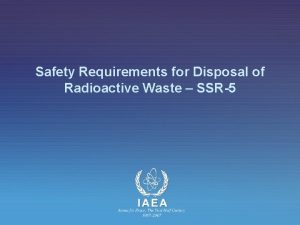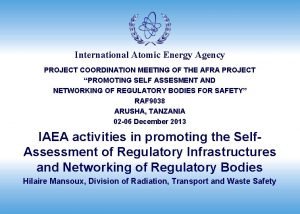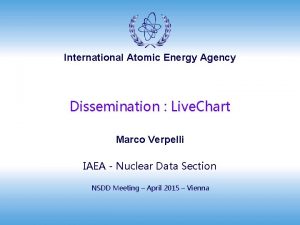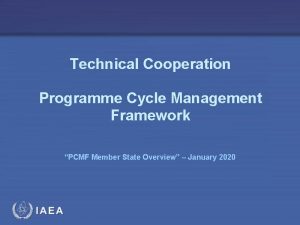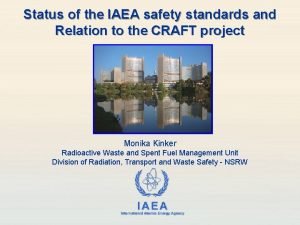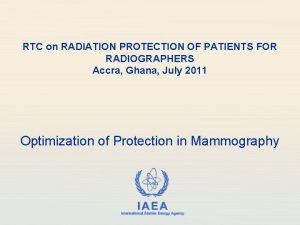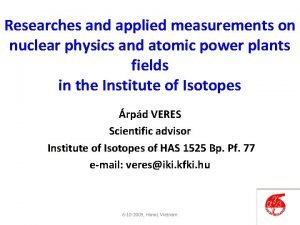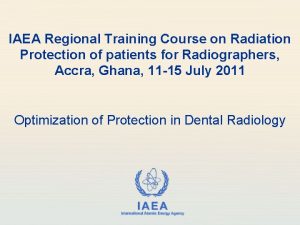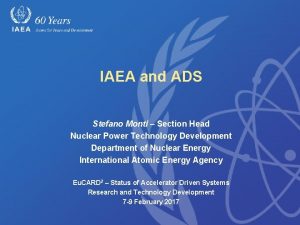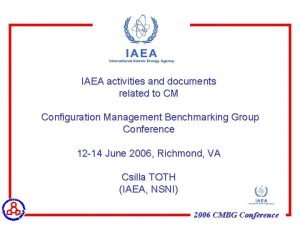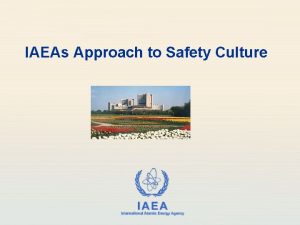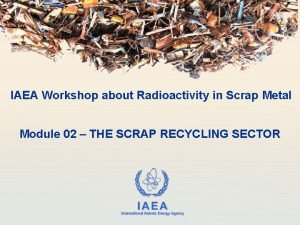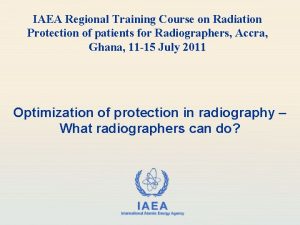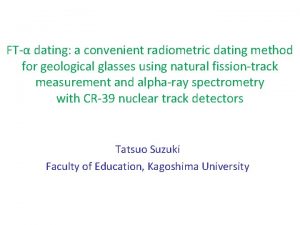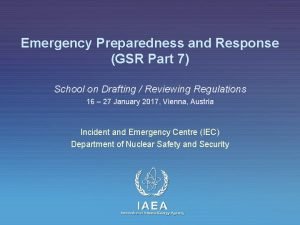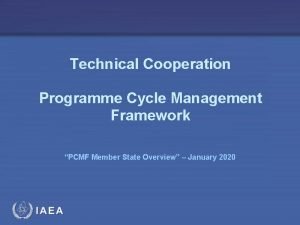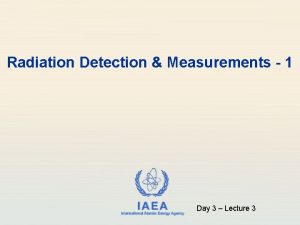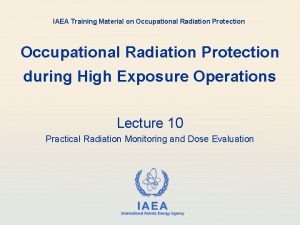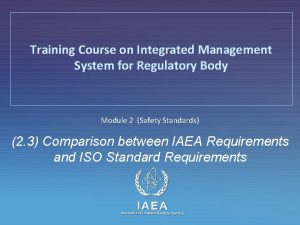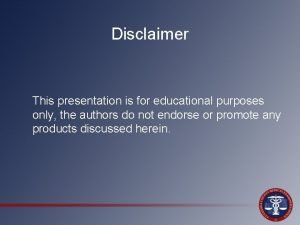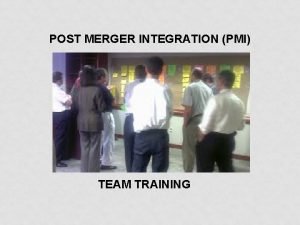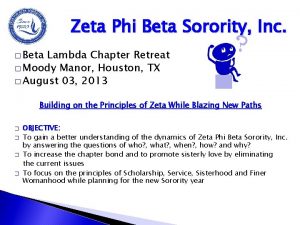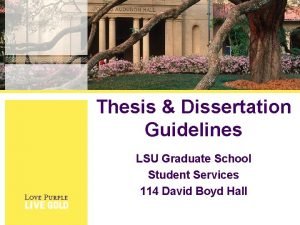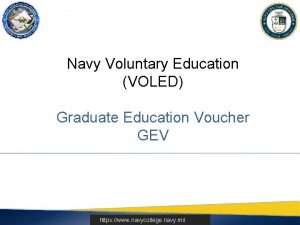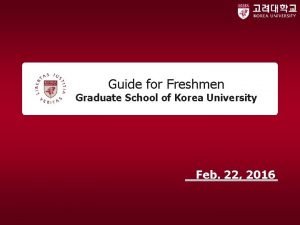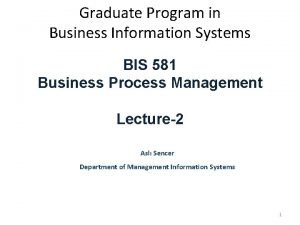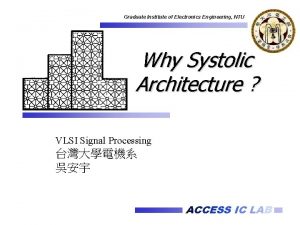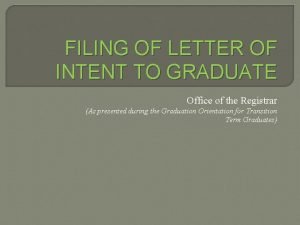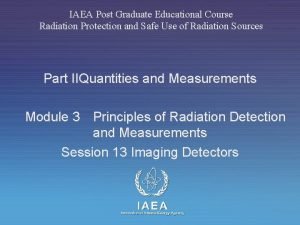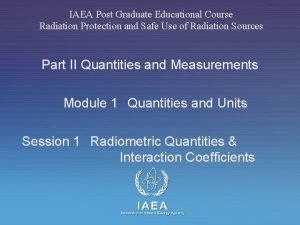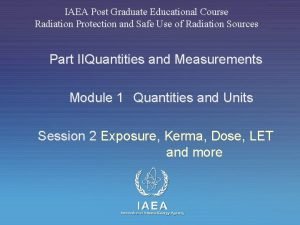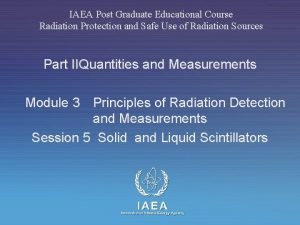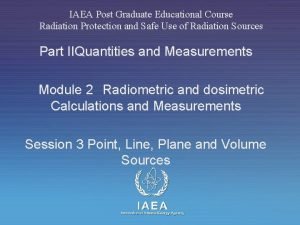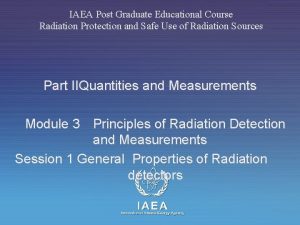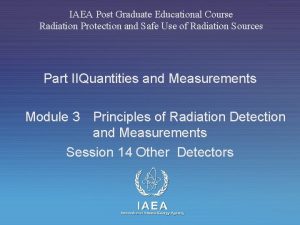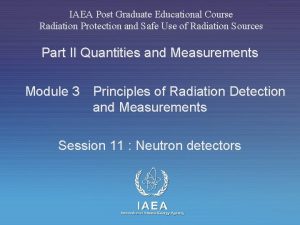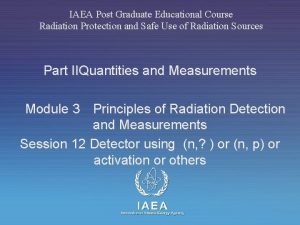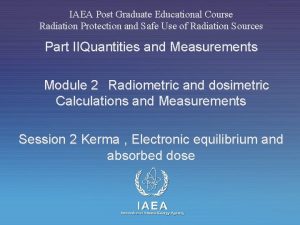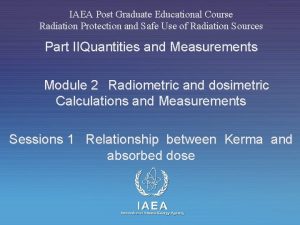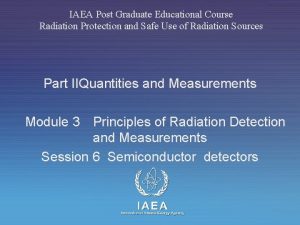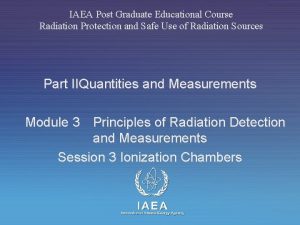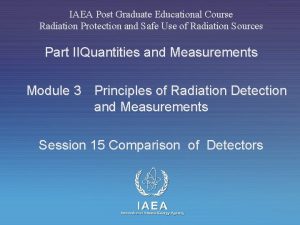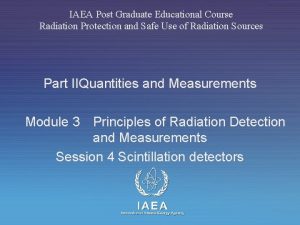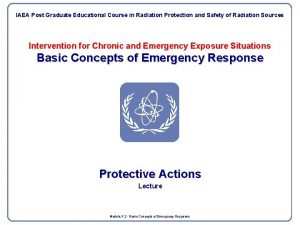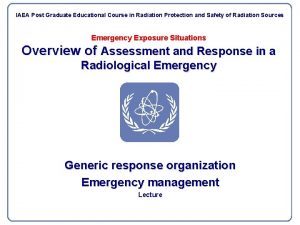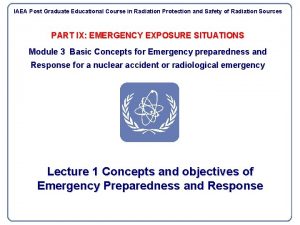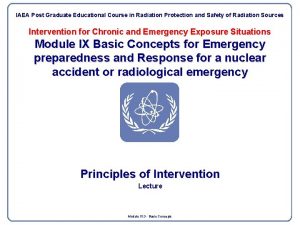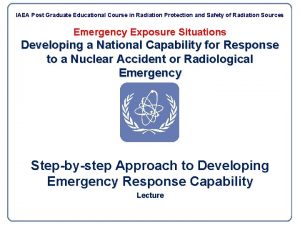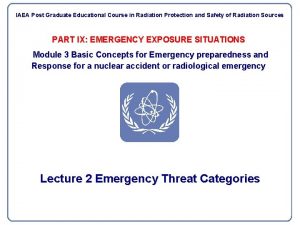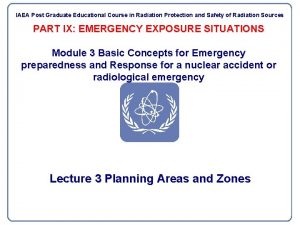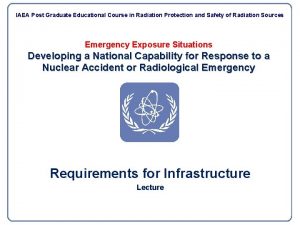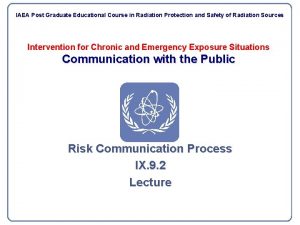IAEA Post Graduate Educational Course in Radiation Protection





























































- Slides: 61

IAEA Post Graduate Educational Course in Radiation Protection and Safety of Radiation Sources Emergency Exposure Situations Overview of Assessment and Response in a Nuclear Reactor Emergency Past reactor accidents and lessons learned Lecture

Introduction Emergencies at facilities in threat categories I, II or III Can include: l l l Nuclear reactors (research reactors, ship reactors and power reactors); Storage facilities for large quantities of spent fuel or liquid or gaseous radioactive material; Fuel cycle facilities (e. g. fuel processing plants);

Content l Nuclear facility emergencies n Reactors: s TMI emergency s Chernobyl emergency l Common aspects and lessons learnt

Three Mile Island Emergency 4: 00 Lost Normal Heat Removal Lost

Chain of Misunderstanding and Incorrect Readings During a shut down, the PORV stuck open resulting in the loss of cooling water (LOCA) Operators did not recognise the PORV was stuck open

TMI Emergency Operators turned the ECCS coolant water off because the pressurizer indicated the vessel was full of water. IT WAS NOT!!!

TMI Emergency Core uncovered at about 06: 00. Gap release at about 06: 30. By 07: 30, there was 40 tons of melted Core. It was not cooled when covered with water

TMI Indicators of Core Damage

TMI Emergency Releases 1016 Bq Xe & Kr 1010 Bq I-131 Released by leakage during recirculation of coolant 1 m. Sv/h near the plant (100 m. R/h) Expect for all core damage accidents, if containment holds

TMI Emergency Shifting winds resulted in excess doses in all directions near the plant

TMI Lesson l Managers directing initial response were ineffective n l Were overwhelmed n Confused n Were unaware of plans Senior managers did not participate in training or exercise (too busy!)

TMI Lesson l Several locations/people talking to the media resulted in: Confusion n Conflicting information n Public and media mistrust of government response n l Fixed when President of US had all information to media provided from single location close to the facility

Accident at Chernobyl NPP (26 April 1986)

Emergency at the Chernobyl NPP On April 25, 1986, prior to a routine shut-down, the reactor crew at Chernobyl-4 began preparing for a test to determine how long turbines would spin and supply power following a loss of the main electrical power supply. Similar tests had already been carried out at Chernobyl and other plants, despite the fact that these reactors were known to be very unstable at low power settings.

Emergency at the Chernobyl NPP A series of operator actions, including the disabling of automatic shutdown mechanisms, preceded the attempted test early on 26 April. As the flow of coolant water diminished, power output increased. When the operator tried to shut down the reactor from its unstable condition arising from previous errors, a peculiarity of the design caused a dramatic power surge.

Emergency at the Chernobyl NPP A series of operator actions, including the disabling of automatic shutdown mechanisms, preceded the attempted test early on 26 April. As the flow of coolant water diminished, power output increased. When the operator tried to shut down the reactor from its unstable condition arising from previous errors, a peculiarity of the design caused a dramatic power surge.

Emergency at the Chernobyl NPP A series of operator actions, including the disabling of automatic shutdown mechanisms, preceded the attempted test early on 26 April. As the flow of coolant water diminished, power output increased. When the operator tried to shut down the reactor from its unstable condition arising from previous errors, a peculiarity of the design caused a dramatic power surge.

Emergency at the Chernobyl NPP The fuel elements ruptured and the resultant explosive force of steam lifted off the cover plate of the reactor, releasing fission products into the atmosphere. A second explosion threw out fragments of burning fuel and graphite from the core and allowed air to rush in, causing the graphite moderator to burst into flames.

Emergency at the Chernobyl NPP The graphite burned for nine days, causing the main release of radioactivity into the environment. A total of about 14 x 1018 Bq of radioactivity was released.

Emergency at the Chernobyl NPP The Chernobyl emergency in 1986 was the result of a flawed reactor design that was operated with inadequately trained personnel without proper regard for safety. It was a direct consequence of the lack of any safety culture.

Emergency at the Chernobyl NPP The Causes • Disabled emergency systems • Did not follow procedures • Unstable design • “Did not believe it could happen”

Chernobyl reactor accident Total contaminated surface (> 1 Ci/km 2): 1 000 km 2 Near zone (<100 km): deposition of heavy particles ( Sr, Pu. . . Far zone (up to 2000 km) : deposition of volatile elements (I, Cs) Module Medical XIX-(15) 22

The Result l l An immense increase in power (1000 times) Destruction of core and confinement structure Major releases continued for 10 days Release of n n l large fraction of noble gases Iodine Caesium Other fission products Total release: n ~ 14 x 1018 Bq

Chernobyl disaster: radionuclides released

Main radionuclides contributing to health effects n iodine - 131 n n n volatile T 1/2: 8 day disappears from environment in 2 months inhalation and ingestion concentrates in thyroid n caesium-137 n n n volatile T 1/2: 30 years stays long in environment body elimination in about 100 days homogenous distribution in all organs and soft tissues

Consequences l 134 cases of Acute Radiation Syndrome (ARS) among responders n n l l 28 died in 1986 from a combination of high external doses of -exposure and skin burns due to -emitters 19 died in 1987 -2004 from various causes, not all linked to radiation ~ 120, 000 persons evacuated Food restrictions: up to 1000 km

On-site Impact l l About 1, 200 people on-site (NPP staff, firemen, emergency workers) Very high doses on-site 28 responders died in 1986 due to ARS Contributors to high dose formation n Training for severe conditions Inadequate protective equipment Instruments were off scale 27

Off-site Impact: Dose Rate Near Chernobyl, R/h 28

Off-site Deposition Complex Local and Regional Patterns 29

Off-site Impact l l Near the facility, doses were sufficient to result in early deaths (> 1 Gy/h) off-site Off-site detection actions were delayed – due to a lack of planning- for 24 hours Early deaths off-site could have resulted, except the plume impacted an uninhabited area Release over several days resulted in a very complex and widespread contamination n n Locally Internationally 30

Long-term Impact l Relocation: 1989 -1993 n l Very conservative criteria used for relocation: n n n l 220, 000 people Not based on international guidance Many people receiving compensation Required large percentage of national budget Use of conservative assumptions to alleviate public concern results in: n n Increased public perception of the risks Loss of trust due inconsistency with statement of risk 31

Erythema on a Chernobyl fireman on Day 17 (primarily from beta radiation)

Severe multiple necrotic-ulcerative radiation burns in Chernobyl fireman on Day 40 after the accident

Lloyd, D. C. : Chromosome analysis to assess radiation dose, Stem Cells, 15: 195 -201, 1997

Module Medical XIX-(15) 35

l In 1987 -2000 14 in 106 confirmed ARS patients died for different reasons l Cause of death only in three cases (Myelodysplastic syndrome) may be associated with II-III degree of ARS n [Ref. : UNSCEAR Report 2000, Part II, Table 55, p. 542, United Nations, New York, 2000]


Human data on radiation cancerogenesis 38

Thyroid cancer and ionizing radiation l Chernobyl accident shows that exposure to iodine isotopes may cause increase in prevalence of thyroid carcinoma l In 1990 -2000 about 1800 thyroid cancers observed in 18 million children and adolescents, i. e. under 18 years old, living in the most contaminated areas of Belarus, Ukraine and Russia

Post-Chernobyl thyroid cancer • increase observed mainly in children under 15 • incidence rates increased by 100 in the most affected areas (Gomel, Belarus and North of the Ukraine) in 1990 -94 • incidence rate multiplied by 3 in adults (Belarus)

Impact of Release - Iodine l l l Rapid increase of thyroid cancer incidence in children Caused by ingestion of milk and leafy vegetables contaminated by 131 I Could easily have been prevented 41

Childhood thyroid cancer around Chernobyl in 1986 -1998 (children <15 years old at diagnosis) [UNSCEAR: Exposures and Effects of the Chernobyl Accident, Annex J, New York, 2000]

Incidence of childhood thyroid cancer (<15 years old at diagnosis) around Chernobyl in 1986 -1998 Incidence, number of new cases in 100 000 children per year [UNSCEAR: Exposures and Effects of the Chernobyl Accident, Annex J, New York, 2000]

Thyroid cancer around Chernobyl in 1986 -1998 (Annual number of cases among ~18 M citizens <18 years old in 1986) [UNSCEAR: Exposures and Effects of the Chernobyl Accident, Annex J, New York, 2000] Total No. of thyroid cc. in 13 years =1791 -

Clinical and epidemiological features of childhood thyroid carcinomas diagnosed in Belarus Chernobyl accident l less influenced by gender n l female/male ratio was 1. 4: 1. 0 (spontaneous: 2. 5/1) mean age n n n At time of first diagnosis: 9. 4± 2. 8 years At time of the accident: 3. 8 ± 2. 4 years More than 90% of the patients were less than 6 years old and 3% were still in utero at time of accident.

Morphological analysis of post-Chernobyl childhood thyroid carcinomas l l Large majority are papillary carcinomas, very few follicular histotype. Among papillary type, many (33%) solid and follicular variants Focal micropapillary hyperplasia frequently found in post-Chernobyl thyroid glands J Clin endocrinol Metab 1997; 82: 3563 Cancer 1994; 74: 748 J Clin Endocrinol metab 1996; 81: 9 -14

Distribution of thyroid doses in children and adolescents in Belarus and the Ukraine %

Thyroid doses in I-131 therapy vs radiation induced thyroid carcinoma -500 Gy I-131 therapy of differentiated thyroid carcinoma -250 Gy -100 Gy -70 Gy -0. 15 -5. 7 Gy I-131 therapy of hyperthyroidism radiation induced thyroid carcinoma

Other factors contributing to the increased rate of childhood thyroid cancer around Chernobyl n n moderate to severe iodine deficiency late iodine prophylaxis (or thyroid blocking in many villages and towns not evacuated) active screening (ultrasound, fine needle biopsy) manifesting also the occult cases awareness (parents request more thyroid examinations of their children than before)

Leukemia and other cancer l No significant increase in leukemia or cancer other than thyroid; solid tumor observed in Chernobyl cleanup workers* l Tendency for elevated leukemia rates, however, among those who received significant doses while working on site in 1986 and 1987. So far statistically significant leukemia excess reported for Russian cleanup workers only**

Psychological disorders l l l Significant psychological disorders caused by mental distress, among most frequent consequences of accident Psychological effects of Chernobyl accident mainly due to lack of reliable public information Distress caused by misperception of radiation risk extremely harmful

Lifetime mortality in population of all ages from fatal cancer after exposure to low doses * general public (all age groups) only Summary factor of cancer risk for working population taken to be 400 x 10 -4 Sv-1 Reference ICRP, Publ. 60, 1991

Attributable lifetime risk, % per sievert Attributable lifetime risk of fatal cancer depending on age at exposure Age at time of exposure

Module Medical XIX-(15) 54

Module Medical XIX-(15) 55

Chernobyl conclusions l l l Radiation burns frequent Burns over 50% of body surface led to death in 19 of 28 cases Internal contamination present in most patients but was significant in few Sepsis was uniform cause of death BMT –very limited indication Some radiation burns did not re-epithelialize, required surgery

Some Response Actions Did More Harm Than Good l l Not based on radiation protection principles Based on criteria developed during emergency and associated with: n n n l Mistrust Emotions Political pressure Some action was taken, just to show something was being done n Decontamination of areas permanently evacuated Module L-004: Past Facility Emergencies 57

TMI and Chernobyl Lessons l Operators n Did not comprehend severity n Confusion at beginning contributed to cause of emergency n Not prepared for response to severe emergency

One of major lessons identified l l Non-radiological (e. g. detrimental economic, social and psychological) consequences may be worse than direct radiological consequences Lack of pre-established guidance understandable to public and officials contributes to occurrence of non-radiological consequences

These Emergencies Showed Need To: • • • Prepare for severe unlikely events Promptly take protective actions off-site Protect responders under severe conditions Develop criteria before event for long term actions Promptly provide useful and consistent information to the media • Expect complex releases and deposition • Prepare for release across borders Module L-004: Past Facility Emergencies 60

Where to Get More Information l Method for developing arrangements for response to a nuclear or radiological emergency, EPR-METHOD, IAEA, Vienna (2003) - in particular Section 4. 2 n Available for down load from IAEA web site http: //wwwpub. iaea. org/MTCD/publications/PDF/Method 2003_web. pdf
 Radiation protection officer qualifications
Radiation protection officer qualifications Barium sulphate board for radiation protection
Barium sulphate board for radiation protection Cardinal principles of radiation protection
Cardinal principles of radiation protection National radiation protection authority namibia
National radiation protection authority namibia Ssr5
Ssr5 Saris iaea
Saris iaea Iaea livechart
Iaea livechart Pcmf
Pcmf Iaea gsr part 4
Iaea gsr part 4 Rtc protection film
Rtc protection film Iaea
Iaea Iaea
Iaea Stefano monti iaea
Stefano monti iaea Iaea
Iaea Iaea
Iaea Steel scrap
Steel scrap Iaea
Iaea Iaea
Iaea Gsr part7
Gsr part7 Pcmf
Pcmf Film badge dosimeter
Film badge dosimeter Iaea
Iaea Iaea gsr part 2
Iaea gsr part 2 Video disclaimer for educational purposes only
Video disclaimer for educational purposes only Post merger integration course
Post merger integration course T junction brick wall
T junction brick wall Course number and title
Course number and title Course interne course externe
Course interne course externe Zeta phi beta images graphics
Zeta phi beta images graphics Government statistical service graduate scheme
Government statistical service graduate scheme Graduate success attributes
Graduate success attributes Graduate attributes binus
Graduate attributes binus Graduate success attributes utm
Graduate success attributes utm Lsu thesis and dissertation library
Lsu thesis and dissertation library Graduate college jamshedpur
Graduate college jamshedpur Aldirecruitment.co.uk
Aldirecruitment.co.uk 15-780 graduate artificial intelligence
15-780 graduate artificial intelligence School of graduate studies upm
School of graduate studies upm Pfizer uk graduate scheme
Pfizer uk graduate scheme Ogaps tamu degree plan
Ogaps tamu degree plan Navy gev
Navy gev 15-780 graduate artificial intelligence
15-780 graduate artificial intelligence Undergraduate graduate postgraduate
Undergraduate graduate postgraduate Hamline university graduate programs
Hamline university graduate programs Sugang.korea.ac.kr.graduate
Sugang.korea.ac.kr.graduate Georgia requirements for high school graduation
Georgia requirements for high school graduation Usf graduate admissions
Usf graduate admissions Bis graduate program
Bis graduate program Graduate institute of electronics engineering
Graduate institute of electronics engineering Off campus housing by northern arizona university
Off campus housing by northern arizona university Nau graduate college
Nau graduate college Uws graduate attributes
Uws graduate attributes Intent to graduate form
Intent to graduate form Nathan weiss graduate college
Nathan weiss graduate college 15-780 graduate artificial intelligence
15-780 graduate artificial intelligence Graduate capitals
Graduate capitals Sheffield graduate attributes
Sheffield graduate attributes Ogs application deadline
Ogs application deadline Kappa alpha psi incorporation date
Kappa alpha psi incorporation date Woolworths graduate program
Woolworths graduate program Jesus seminary
Jesus seminary Difference between entrepreneurs and managers
Difference between entrepreneurs and managers
